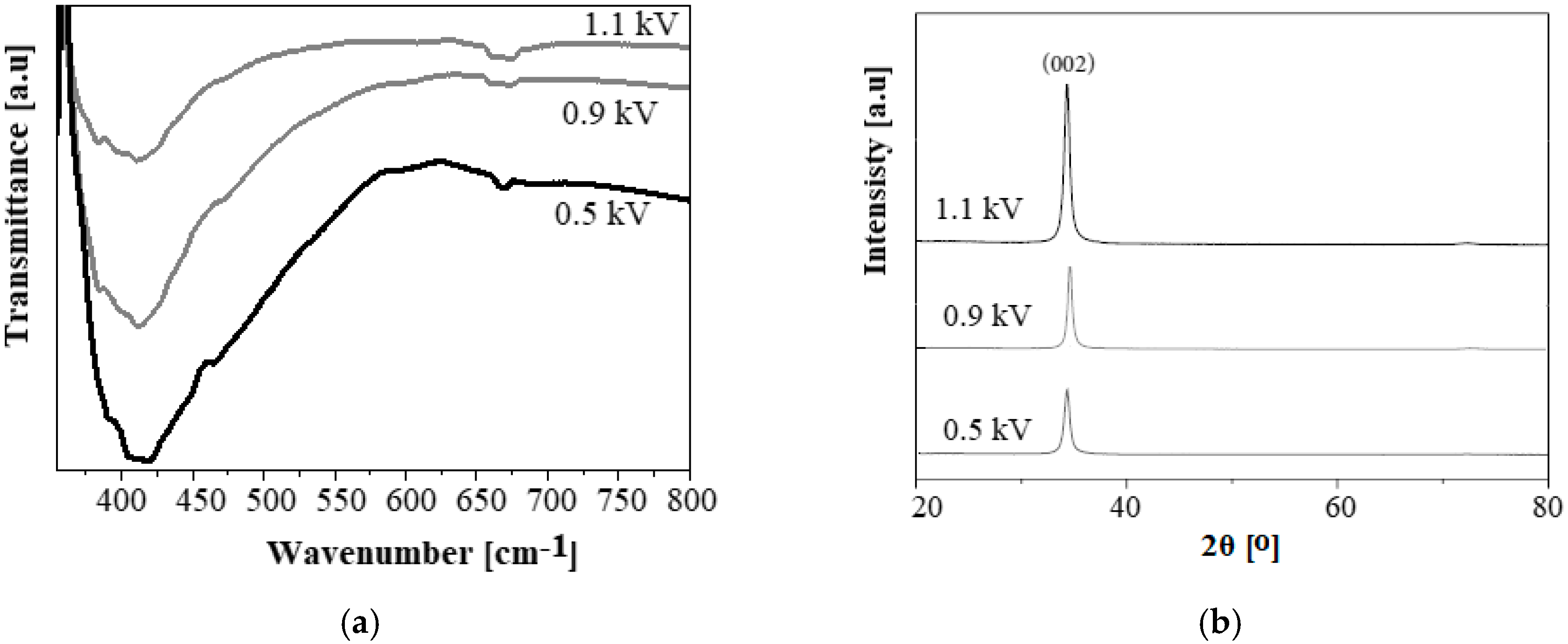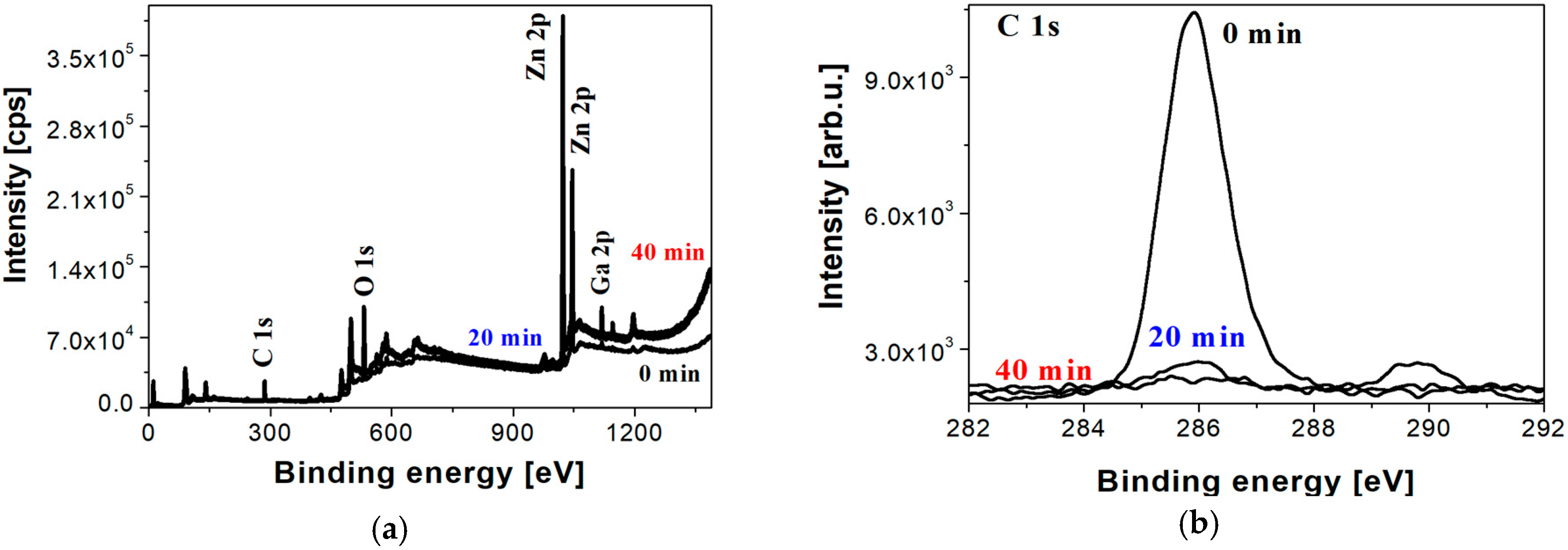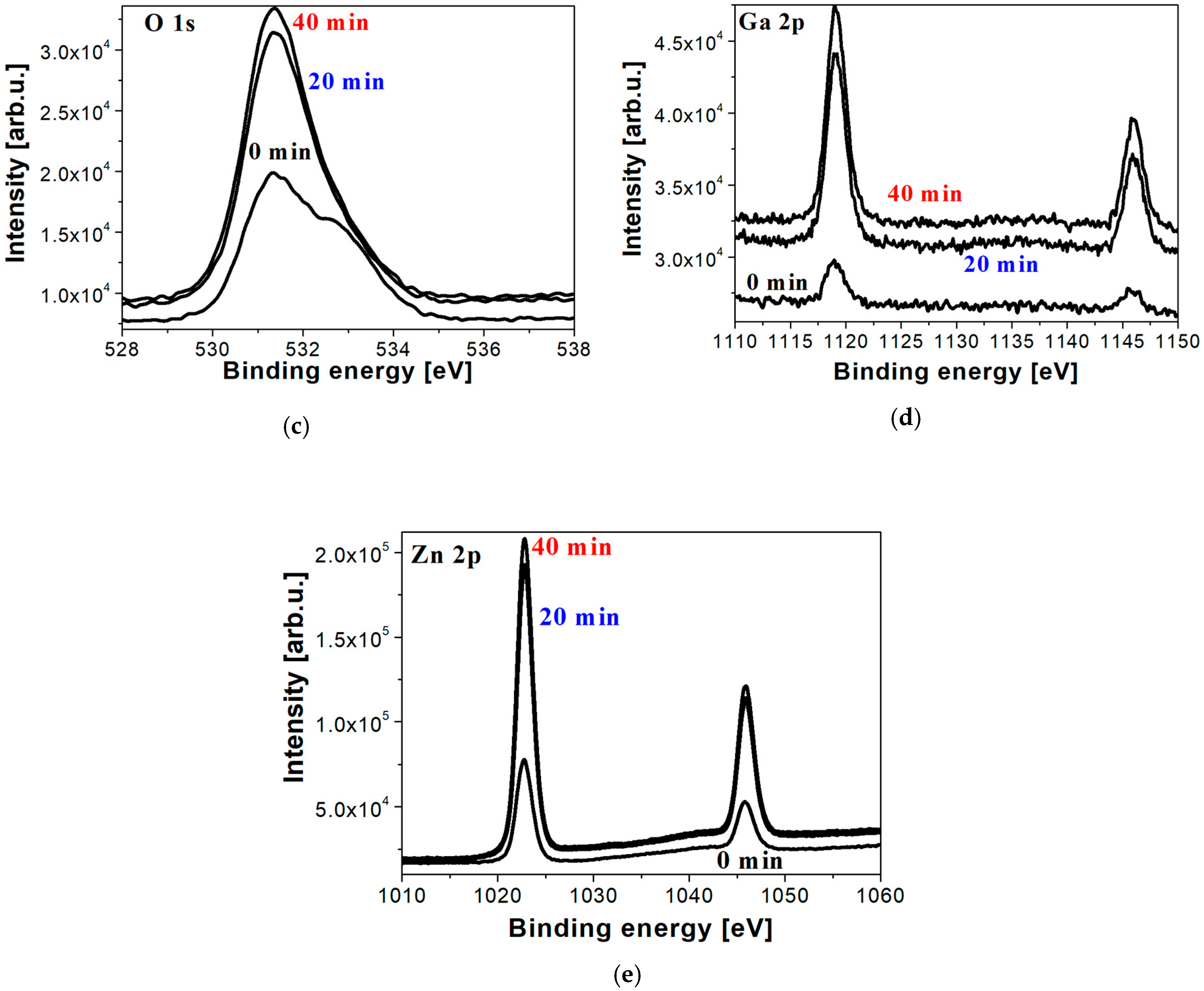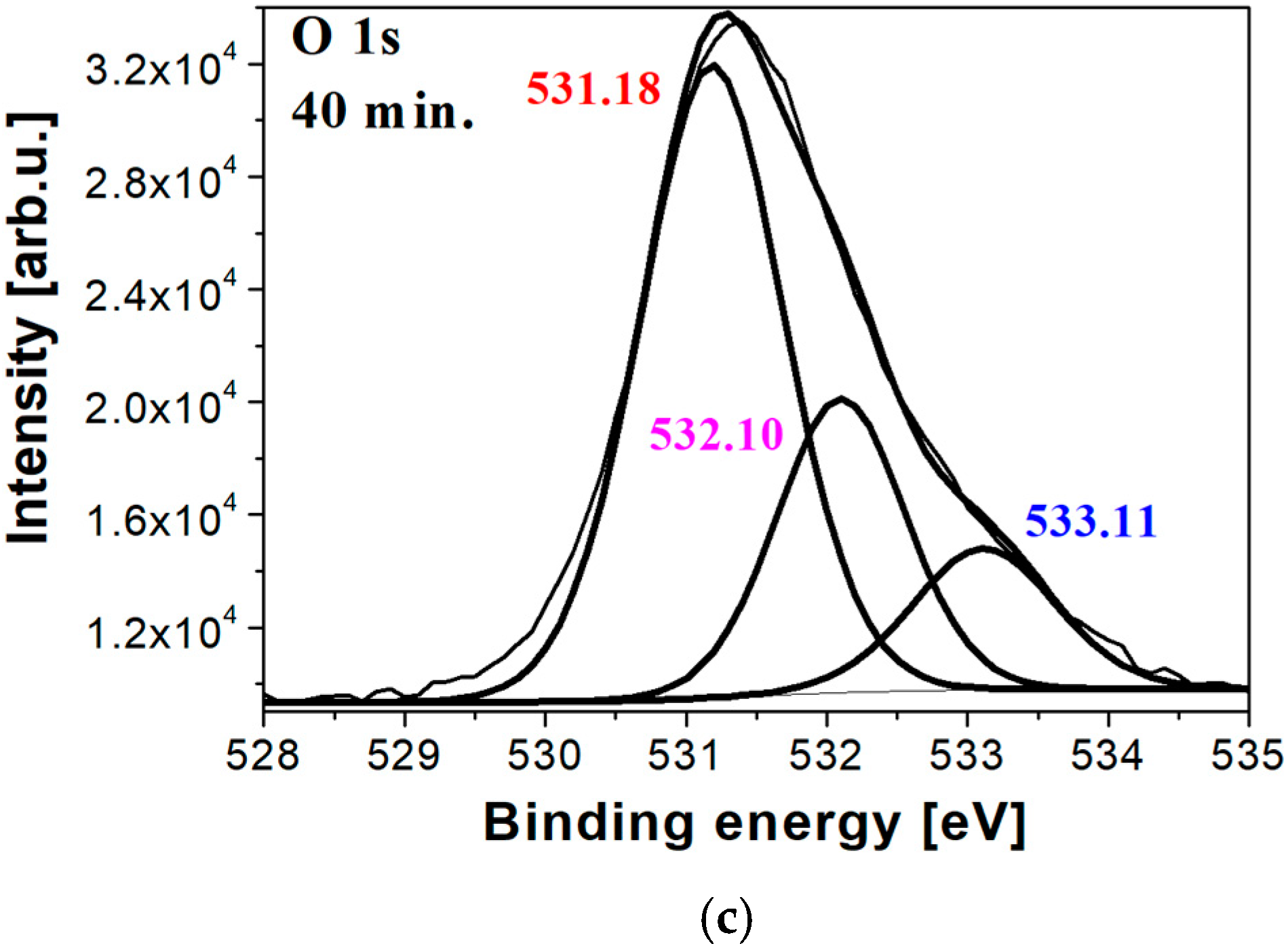Study of Sputtered ZnO:Ga2O3 Films for Energy Harvesting Applications
Abstract
:1. Introduction
2. Materials and Methods
3. Results and Discussion
4. Conclusions
Author Contributions
Funding
Acknowledgments
Conflicts of Interest
References
- Wei, H.; Wang, H.; Xia, Y.; Cui, D.; Shi, Y.; Dong, M.; Liu, C.; Ding, T.; Zhang, J.; Ma, Y.; et al. An overview of lead-free piezoelectric materials and devices. J. Mater. Chem. C 2018, 6, 12446–12467. [Google Scholar] [CrossRef]
- Liu, Q.; Zhang, Y.; Gao, J.; Zhou, Z.; Wang, H.; Wang, K.; Zhang, X.; Lia, L.; Li, J.-F. High-performance lead-free piezoelectrics with local structural heterogeneity. Energy Environ. Sci. 2018, 11, 3531–3539. [Google Scholar] [CrossRef]
- Wu, J. Advances in Lead-Free Piezoelectric Materials; Springer Nature: Singapore, 2018. [Google Scholar]
- Wang, P.; Du, H. ZnO thin film piezoelectric MEMS vibration energy harvesters with two piezoelectric elements for higher output performance. Rev. Sci. Instrum. 2015, 86, 075002. [Google Scholar] [CrossRef] [PubMed]
- Rahman, W.; Garain, S.; Sultana, A.; Middya, T.R.; Mandal, D. Self-powered piezoelectric nanogenerator based on wurtzite zno nanoparticles for energy harvesting application. Mater. Today Proc. 2018, 5, 9826–9830. [Google Scholar] [CrossRef]
- Morisot, F.; Nguyen, V.H.; Montemont, C.; Maindron, T.; Muñoz-Rojas, D.; Mouis, M.; Langlet, M.; Ternon, C. Al2O3, Al doped ZnO and SnO2 encapsulation of randomly oriented ZnO nanowire networks for high performance and stable electrical devices. Nanotechnology 2019, 30, 385202. [Google Scholar] [CrossRef]
- Zhao, H.; Hu, J.; Chen, S.; Xie, Q.; He, J. High nonlinearity and high voltage gradient ZnO varistor ceramics tailored by combining Ga2O3, Al2O3, and Y2O3 dopants. J. Am. Ceram. Soc. 2016, 99, 769–772. [Google Scholar] [CrossRef]
- Parida, B.; Jeong, S.; Kim, H. Effects of Al diffusion process on the electrical, optical, and structural properties of transparent conducting Al-doped ZnO. J. Korean Phys. Soc. 2018, 73, 917–921. [Google Scholar] [CrossRef]
- Gu, J.H.; Lu, Z.; Long, L.; Zhong, Z.Y.; Yang, C.Y.; Hou, J. Preparation, structure and optical properties of transparent conducting gallium-doped zinc oxide thin films. Mater. Sci. Pol. 2015, 33, 470–481. [Google Scholar] [CrossRef] [Green Version]
- Zhao, H.; Hu, J.; Chen, S.; Xie, Q.; He, J. Tailoring the high-impulse current discharge capability of ZnO varistor ceramics by doping with Ga2O3. Ceram. Int. 2016, 42, 5582–5586. [Google Scholar] [CrossRef]
- Hyman, D.; Mehregany, M. Contact physics of gold microcontacts for MEMS switches. IEEE Trans. Compon. Pack. T. 1999, 22, 357–364. [Google Scholar] [CrossRef]
- Pennec, F.; Peyrou, D.; Leray, D.; Pons, P.; Plana, R.; Courtade, F. Impact of the surface roughness description on the electrical contact resistance of ohmic switches under low actuation forces. IEEE Trans. Compon. Pack. T. 2012, 2, 85–94. [Google Scholar] [CrossRef] [Green Version]
- Fu, X.; Gao, L.; Zhang, Q.; Liu, Q. Surface roughness research of piezoelectric self-adaptive micro-EDM. Procedia CIRP 2016, 42, 563–568. [Google Scholar] [CrossRef]
- Aleksandrova, M. Polymeric seed layer as a simple approach for nanostructuring of Ga-doped ZnO films for flexible piezoelectric energy harvesting. Microelectron. Eng. (In Press).
- Skinner, S. Energy Storage and Conversion Materials; Royal Society of Chemistry: Croydon, UK, 2019. [Google Scholar]
- Zhao, H.; He, J.; Hu, J.; Chen, S.; Xie, Q. High nonlinearity and low residual-voltage ZnO varistor ceramics by synchronously doping Ga2O3 and Al2O3. Mater. Lett. 2016, 164, 80–83. [Google Scholar] [CrossRef]
- Reinhardt, K.; Kern, W. Handbook of Silicon Wafer Cleaning Technology; William Andrew: Oxford, UK, 2018. [Google Scholar]
- Aleksandrova, M.; Kolev, G.; Vucheva, Y.; Pathan, H.; Denishev, K. Characterization of piezoelectric microgenerator with nanobranched zno grown on a polymer coated flexible substrate. Appl. Sci. 2017, 7, 890. [Google Scholar] [CrossRef] [Green Version]
- Kwon, Y.J.; Kim, K.H.; Lim, C.S.; Shim, K.B. Characterization of ZnO nanopowders synthesized by the polymerized complex method via an organochemical route. J. Ceram. Process. Res. 2002, 3, 146–149. [Google Scholar]
- Khan, Z.R.; Khan, M.S.; Zulfequar, M.; Khan, M.S. Optical and structural properties of ZnO thin films fabricated by sol-gel method. Mater. Sci. Appl. 2011, 2, 340–345. [Google Scholar] [CrossRef] [Green Version]
- Goswami, N.; Sahai, A. Structural transformation in nickel doped zinc oxide nanostructures. Mater. Res. Bull. 2013, 48, 346–351. [Google Scholar] [CrossRef]
- Ghazali, N.M.; Mahmood, M.R.; Yasui, K.; Hashim, A.M. Electrochemically deposited gallium oxide nanostructures on silicon substrates. Nanoscale Res. Lett. 2014, 9, 120. [Google Scholar] [CrossRef] [Green Version]
- Music, S.; Dragovic, D.; Popovic, S. Influence of synthesis route on the formation of ZnO particles and their morphologies. J. Alloy. Compd. 2007, 429, 242–249. [Google Scholar] [CrossRef]
- Yang, J.; Zhao, Y.; Frost, R.L. Infrared and infrared emission spectroscopy of gallium oxide α-GaO(OH) nanostructures. Spectrochem. Acta A Mol. Biomol. Spetroscopy 2009, 74, 398–403. [Google Scholar] [CrossRef] [PubMed] [Green Version]
- Ravichandrana, K.; Rathi, R.; Baneto, M.; Karthika, K.; Rajkumar, P.V.; Sakthivel, B.; Damodaran, R. Effect of Fe+F doping on the antibacterial activity of ZnO powder. Ceram. Int. 2015, 41, 3390–3395. [Google Scholar] [CrossRef]
- Zunke, I.; Heft, A.; Schäfer, P.; Haidu, F.; Lehmann, D.; Grünler, B.; Schimanski, A.; Zahn, D.R.T. Conductive zinc oxide thin film coatings by combustion chemical vapour deposition at atmospheric pressure. Thin Solid Film. 2013, 532, 50–55. [Google Scholar] [CrossRef]
- Petrović, Ž.; Ristić, M.; Musić, S. Development of ZnO microstructures produced by rapid hydrolysis of zinc acetylacetonate. Ceram. Int. 2014, 40, 10953–10959. [Google Scholar] [CrossRef]
- Khan, A.; Abas, Z.; Kim, H.S.; Oh, I.K. Piezoelectric thin films: An integrated review of transducers and energy harvesting. Smart Mater. Struct. 2016, 25, 053002. [Google Scholar] [CrossRef]
- Hamaguchi, S. Plasma-surface Interactions in Material Processing. J. Phys. Conf. Ser. 2010, 257, 012007. [Google Scholar] [CrossRef] [Green Version]
- Liu, W.; Du, G.; Sun, Y.; Xu, Y.; Yang, T.; Wang, X.; Chang, Y.; Qiu, F. Al-doped ZnO thin films deposited by reactive frequency magnetron sputtering: H2-induced property changes. Thin Solid Film. 2007, 515, 3057–3060. [Google Scholar] [CrossRef]
- Chen, Y.; Hu, Y.; Meng, Q.; Yan, H.; Shuai, W.; Zhang, Z. Natively textured surface of Ga-doped ZnO films electron transporting layer for perovskite solar cells: Further performance analysis from device simulation. J. Mater. Sci. Mater. Electron. 2019, 30, 4726–4736. [Google Scholar] [CrossRef]
- Greene, J.E. Tracing the recorded history of thin-film sputter deposition: From the 1800s to 2017 featured. J. Vac. Sci. Technol. A 2017, 35, 05C204. [Google Scholar] [CrossRef] [Green Version]
- Frey, H.; Khan, H.R. Handbook of Thin Film Technology; Springer Science & Business Media: Berlin, Germany, 2015. [Google Scholar]
- Hashimi, S. Comprehensive Materials Processing; Elsevier: Amsterdam, The Netherlands, 2014. [Google Scholar]
- You, Z.Z.; Hua, G.J. Electrical, optical and microstructural properties of transparent conducting GZO thin films deposited by magnetron sputtering. J. Alloy. Comp. 2012, 530, 11–17. [Google Scholar] [CrossRef]
- Alfaro Cruz, M.R.; Ceballos-Sanchez, O.; Luévano-Hipólito, E.; Torres-Martínez, L.M. ZnO thin films deposited by RF magnetron sputtering: Effects of the annealing and atmosphere conditions on the photocatalytic hydrogen production. Intern. J. Hydrog. Energy 2018, 43, 10301–10310. [Google Scholar] [CrossRef]
- Kim, D.; Hwang, I.; Son, J.; Kim, H. Inductively coupled-plasma dry etching of a ZnO thin film by Ar-diluted CF4 gas. J. Korean Phys. Soc. 2011, 58, 1536–1540. [Google Scholar] [CrossRef]
- Li, G.; Wang, H.; Wang, Q.; Zhao, Y.; Wang, Z.; Du, J.; Ma, Y. Structure and properties of Co-doped ZnO films prepared by thermal oxidization under a high magnetic field. Nanoscale Res. Lett. 2015, 10, 112. [Google Scholar] [CrossRef] [Green Version]
- Khokhra, R.; Bharti, B.; Lee, H.N.; Kumar, R. Visible and UV photo-detection in ZnO nanostructured thin films via simple tuning of solution method. Sci. Rep. 2017, 7, 15032. [Google Scholar] [CrossRef] [PubMed] [Green Version]
- Hosseini, S.M.; Abdolhosseini, I.; Kameli, S.P.; Salamati, H. Effect of Ag doping on structural, optical, and photocatalytic properties of ZnO nanoparticles. J. Alloy. Compd. 2015, 640, 408–415. [Google Scholar] [CrossRef] [Green Version]
- Kim, S.; Seo, J.; Jang, H.W.; Bang, J.; Lee, W.; Lee, T.; Myoung, J.-M. Effects of H 2 ambient annealing in fully 0 0 2-textured ZnO:Ga thin films grown on glass substrates using RF magnetron co-sputter deposition. Appl. Surf. Sci. 2009, 255, 4616–4622. [Google Scholar] [CrossRef]
- Caglar, Y.; Caglar, M.; Ilican, S. XRD, SEM, XPS studies of Sb doped ZnO films and electrical properties of its based Schottky diodes. Optik 2018, 164, 424–432. [Google Scholar] [CrossRef]
- Abdel-Wahab, M.S.; Jilani, A.; Yahia, I.S.; Al-Ghamdi, A.A. Enhanced the photocatalytic activity of Ni-doped ZnO thin films: Morphological, optical and XPS analysis. Superlattice. Microstruct. 2016, 94, 108–118. [Google Scholar] [CrossRef]
- Saaedi, A.; Yousefi, R.; Jamali-Sheini, F.; Zak, A.K.; Cheraghizade, M.; Mahmoudian, M.R.; Baghchaesara, M.A.; Dezaki, A.S. XPS studies and photocurrent applications of alkali-metals-doped ZnO nanoparticles under visible illumination conditions. Physica E 2016, 79, 113–118. [Google Scholar] [CrossRef]
- Joshi, A.; Rauch, J.-Y.; Bodas, D.; Gangal, S. Effect of oxygen vacancies on crystallization and piezoelectric performance of PZT. Ferroelectrics. 2016, 494, 117–122. [Google Scholar]
- Kurt Lesker Company. Zinc Gallium Oxide (Pieces). Available online: https://www.lesker.com/msds/pdfs/2e3d1f05d1b63e7e6db640f6b90980b76759deebf309560e5d6f9fd483e0cd54.pdf (accessed on 30 May 2020).
- Briscoe, J.; Jalali, N.; Woolliams, P.; Stewart, M.; Weaver, P.M.; Cain, M.; Dunn, S. Measurement techniques for piezoelectric nanogenerators. Energy Environ. Sci. 2013, 6, 3035–3045. [Google Scholar] [CrossRef]
- Chen, K.-H. Power Management Techniques for Integrated Circuit Design; John Wiley & Sons: Singapore, 2016. [Google Scholar]
- Collins, D. Mechanical Properties of Materials: Stress and Strain. Available online: https://www.linearmotiontips.com/mechanical-properties-of-materials-stress-and-strain/ (accessed on 5 July 2020).
- Yamamoto, N.; Makino, H.; Yamamoto, T. Young’s modulus and coefficient of linear thermal expansion of ZnO conductive and transparent ultra-thin films. Adv. Mat. Sci. Eng. 2011, 2011, 136127. [Google Scholar] [CrossRef] [Green Version]
- Choi, H.Y.; Jeong, Y.G. Microstructures and piezoelectric performance of eco-friendly composite films based on nanocellulose and barium titanate nanoparticle. Compos. Part B Eng. 2019, 168, 58–65. [Google Scholar] [CrossRef]
- Marzencki, M.; Basrour, S.; Charlot, B.M.; Grasso, A.; Colin, M.; Valbin, L. Design and fabrication of piezoelectric micro power generators for autonomous microsystems. In Proceedings of the Design, Test, Integration and Packaging of MEMS/MOEMS, Montreux, Switzerland, 1–3 June 2005; pp. 299–302. [Google Scholar]
- Stassi, S.; Cauda, V.; Ottone, C.; Chiodoni, A.; Pirri, C.F.; Canavese, G. Flexible piezoelectric energy nanogenerator based on ZnO nanotubes hosted in a polycarbonate membrane. Nano Energy 2015, 13, 474–481. [Google Scholar] [CrossRef]
- Fakhri, P.; Amini, B.; Bagherzadeh, R.; Kashfi, M.; Latifi, M.; Yavari, N.; Kanice, S.A.; Kong, L. Flexible hybrid structure piezoelectric nanogenerator based on ZnO nanorod/PVDF nanofibers with improved output. RSC Adv. 2019, 9, 10117–10123. [Google Scholar] [CrossRef] [Green Version]
- Aleksandrova, M.; Ivanova, T.; Koch, S.; Hamelmann, F.; Karashanova, D.; Gesheva, K. Study of sputtered barium strontium titanate films for energy harvesting applications. Adv. Mater. Lett. in press.








| Absorption Bands and Positions [cm−1] | Assigned To | ||
|---|---|---|---|
| 1.1 kV | 0.9 kV | 0.5 kV | |
| 3737.1 very weak | – | – | Stretching vibrations of free hydroxyl groups [20] |
| 2358.7 clear | 2358.7 weak | 2358.7 clear | CO2 vibrations due to atmospheric air [19] |
| 2329.7 clear | 2329.7 weak | 2329.7 clear | |
| 668.1 very clear | 668.1 very clear | 668.1 very clear | Stretching Zn–O [21] Ga-O bonding Ga2O3 [22] |
| 607 weak shoulder | – | – | Zn–O [23] |
| – | – | 598.8 weak shoulder | Zn–O [23] |
| 475 very weak | 475 weak shoulder | 475 clear | Deformation modes of Ga2O6 [24] or Zn–O stretching [25] |
| 401 strong, broad 365–450 | 410 strong, broad 365–460 | 418 strong, broad 365–475 | Zn–O stretching [26] Characteristic for wurtzite phase [27] |
| 383.1 clear | 385 clear | 389 clear | Zn–O stretching [26] |
| Sputtering Time (min) | C 1s, at.% | O 1s, at.% | Ga 2p, at.% | Zn 2p, at.% |
|---|---|---|---|---|
| 0 | 53.6 | 37.77 | 0.32 | 8.32 |
| 20 | 2.69 | 64.27 | 3.85 | 29.19 |
| 40 | 2.38 | 63.99 | 3.82 | 29.81 |
| Sputtering Time (min) | C 1s, at.% | O 1s, at.% | Ga 2p, at.% | Zn 2p, at.% |
|---|---|---|---|---|
| 0 | 55.88 | 35.39 | 0.34 | 8.38 |
| 20 | 3.51 | 64.82 | 2.05 | 29.63 |
| 40 | 1.45 | 66.39 | 2.05 | 28.71 |
| Lead-Free Materials | Film Thickness, μm | Power Density, µW/cm2 | Frequency, Hz | Area, cm2 |
|---|---|---|---|---|
| AlN [52] | 1 | 0.038 | 204 | 1 |
| ZnO nanotubes [53] | 5 | 5.63 | 75 | 8 |
| ZnO nanorod/PVDF [54] | 2 | 0.8 | 6 | 3 |
| BaSrTiO3 [55] | 0.52 | 0.27 | 50 | 4 |
| This work | 0.60 | 1.4 | 50 | 3 |
© 2020 by the authors. Licensee MDPI, Basel, Switzerland. This article is an open access article distributed under the terms and conditions of the Creative Commons Attribution (CC BY) license (http://creativecommons.org/licenses/by/4.0/).
Share and Cite
Aleksandrova, M.; Ivanova, T.; Hamelmann, F.; Strijkova, V.; Gesheva, K. Study of Sputtered ZnO:Ga2O3 Films for Energy Harvesting Applications. Coatings 2020, 10, 650. https://doi.org/10.3390/coatings10070650
Aleksandrova M, Ivanova T, Hamelmann F, Strijkova V, Gesheva K. Study of Sputtered ZnO:Ga2O3 Films for Energy Harvesting Applications. Coatings. 2020; 10(7):650. https://doi.org/10.3390/coatings10070650
Chicago/Turabian StyleAleksandrova, Mariya, Tatyana Ivanova, Frank Hamelmann, Velichka Strijkova, and Kostadinka Gesheva. 2020. "Study of Sputtered ZnO:Ga2O3 Films for Energy Harvesting Applications" Coatings 10, no. 7: 650. https://doi.org/10.3390/coatings10070650
APA StyleAleksandrova, M., Ivanova, T., Hamelmann, F., Strijkova, V., & Gesheva, K. (2020). Study of Sputtered ZnO:Ga2O3 Films for Energy Harvesting Applications. Coatings, 10(7), 650. https://doi.org/10.3390/coatings10070650







